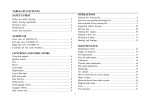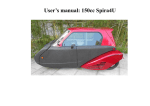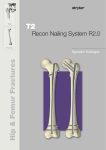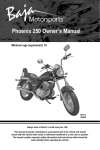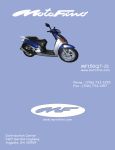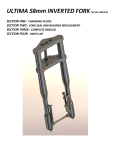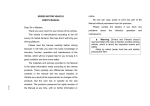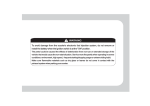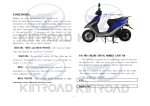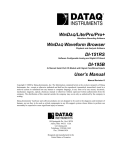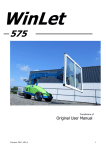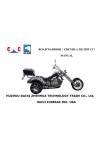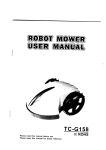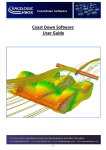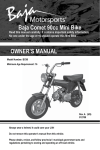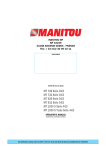Download ÿþM icrosoft W ord - ×e0‡. doc
Transcript
TABLE OF CONTENTS OPERATIONS SAFETY FIRST Parking the motorcycle… … .… … … … … … … .… … … … .… ..… 8 Notice on use gasoline and engine oil… … … … … .… … … … .… ..… 8 Run in period of new motorcycle… .… ..… … … … .… … … … .… ..… 9 Inspection before driving… .… … … … … … … .… … … … .… ..… 10 Driving tips… … … … … ..… .… … … … … … … .… … … … .… ..… 10 Starting the engine.… … ..… .… … … … … … … .… … … … .… ..… 10 Starting to drive on..… … … … … … … … … … … .… … … … .… ..… 11 Driving on a slope....… … … … … … … … … … … .… … … … .… ..… 11 Braking and Parking.… ..… … … … … … … … … .… … … … .… ..… 11 Notice on safety driving… … … … … … … … … … … … … … … … 3 Safety driving regulations.… … … … … … … … … … … … … … .… 3 Protective suits...… … … … … … … … … … … … … … … .… … … … … 3 Modification… … … … … … … … … … … … … … … … … … ...… … 3 Loads and accessory… … … … … … … … … … … … … … … ...… ... 3 SCOOTER Front view of Scooter… … … … … ...… … … … … … … ...… … Left side view of Scooter… … … … .… … … … … … … ...… … Right side view of Scooter… … … .… … … … … … … ...… ..… Locations for the Code Numbers… … .… … … … … .… … ...… ..… 4 4 4 5 MAINTENANCE Maintenance Chart..… … … .… … … … … … … … .… … … … .… ..… 12 Engine oil dipstick.… … … .… … … … … … … … .… … … … .… ..… 13 Oil replacement… ...… … … .… … … … … … … … .… … … … .… ..… 13 Gear oil replacement… … … ....… … … … … … … .… … … … .… ..… 14 Carburetor… … … ...… … … .… … … … … … … … .… … … … .… ..… 14 Throttle cable adjustment… ....… … … … … … … .… … … … .… ..… 14 Idle speed adjustment.… … .… … … … … … … … .… … … … .… ..… 14 Spark plug.… … … … … ..… .… … … … … … … … .… … … … .… ..… 15 Air cleaner..… ..… … … … … … … … … … … … … … … … … … … … 15 How to clean the core of air cleaner… .… … … … … … .… … … .… ..15 Brake system… … … … … … … … ...… .… … … … … … .… … … .… ..16 Drain out the air from brake system… ..… … … … … .. .… … … .… ..16 Replace brake pads… … … … … … ..… ..… … … … … .. .… … … .… ..17 Tires… … ..… … … … … … … … … ...… .… … … … … … .… … … .… ..17 Tire pressure.… … … … … … … … ...… .… … … … … … .… … … .… ..17 CONTROLS AND INDICATORS Using this manual… … … … … … … … … .… … … … … … … ...… ..… 6 Ignition switch… … … … … … … … … .… … … … … … … .… ...… ..… 6 Key… … … … … … … … .… … … … … … … .… … … … … … .… ..… 6 Meter… .… … … … … … … .… … … … … … … .… … … … … .… ..… 6 Left handle… … … … … … … .… … … … … … … .… … … … … .… ..… 6 Right handle… ..… … … … … … .… … … … … … … .… … … … .… ..… 7 Cap of fuel tank....… … … … … .… … … … … … … .… … … … .… ..… 7 Kick start pedal… .....… … … … .… … … … … … … .… … … … .… ..… 7 Rear footrest.… … .....… … … … .… … … … … … … .… … … … .… ..… 8 Helmet hook..… … ....… … … … .… … … … … … … .… … … … .… ..… 8 Front luggage carrier.… … … … .… … … … … … … .… … … … .… ..… 8 Luggage cabinet...… … … … … … … … … … … … … ..… … … … … … .8 Rear carrier rack..… … … … … … … … … … … … … ..… … … … … … .8 1 TABLE OF CONTENTS Tread..… ..… … … … … … … … .… ...… .… … … … … … .… … … .… ..17 Battery… ..… … … … … … … … … ...… .… … … … … … .… … … .… ...17 Fuse… … ..… … … … … … … … … ...… .… … … … … … .… … … .… ..18 Lights… ..… … … … … … … … … ...… .… … … … … … .… … … .… ..18 Bulbs...… ..… … … … … … … … … ...… .… … … … … … .… … … .… ..18 Rear view mirror… … … … … … ...… .… … … … … … .… … … .… ..18 Storage… ..… … … … … … … … … ...… .… … … … … … .… … … .… ..18 Recovery after storage.… … … … ...… .… … … … … … .… … … .… ..18 Tools set… … … … … ....… … … … ...… .… … … … … … .… … … .… ..19 TROUBLESHOOTING General… ..… … … … … … … … … ...… .… … … … … … .… … … .… ..19 Engine.… ..… … … … … … … … … ...… .… … … … … … .… … … .… ..19 Vibration...… … … … … … … … … ...… .… … … … … … .… … … .… ..20 Lubrication system… … … … … … ...… .… … … … … … .… … … .… ..20 Electrical system...… … … … … … ...… .… … … … … … .… … … .… ..20 Transmission.… … … … … … … … ...… .… … … … … … .… … … .… ..20 Brakes… … ...… … … … … … … … ...… .… … … … … … .… … … .… ..21 TECHNICAL SPECIFICATION … … … … … … … … ...… .… … … … … … .… … … .… ..22 2 SAFETY FIRST Notice on safety driving gloves and mask or glasses, and the passenger must wear a helmet too. The clothing should be sheath instead of loose to avoid its being caught by the handlebars, kick-starter, footrests or the wheels. The exhaust system turns hot when running, the driver and passenger should wear trousers and shoes/boots that cover and protect their legs and feet. Don't touch the hot exhaust pipe. Safety must be seriously considered when driving a scooter. Do not drive until you have fully understood the safety requirements and have made a thorough inspection to the scooter. Safety driving regulations 1. Inspection to the scooter must be made before driving in order to prevent any accident or any damage to the components. 2. A driver must take a comprehensive test and obtain a driving license from the traffic authority before he drives a scooter. Don’t drive without a license, and never lend the scooter to anyone without a driving license. 3. In order to avoid possible hurt from other vehicles, a driver should wear bright and visible clothing. Strictly abide by the traffic rules and never contend with other drivers. 4. Keep a distance from other motor vehicles. Don't dash in another lane. Don't drive at a speed beyond that for the road condition there and the speed limit. 5. Switch on the turning signal lights to attract attention when making a turning or changing the lane. Special care should be taken when driving through crosses, or the entry/exit of a parking lot, or on the express lane. In a rainy day when the floor is slippery, care should be taken and drive at reduced speed. 6. Driving with both hands applied to the handles and both feet to the footrests. A passenger should catch the holders of rack tightly and keep both of his feet on the footrests. Modification Warning: You must observe the vehicle regulations stipulated by the state and local authorities, never privately modify or disassembly the original scooter in order to avoid any accident. Loads and accessory Follow the skill as below is good for you load: 1. The total weight of rider, passenger and all of luggage should not be over the maximum load of scooter: 175kg. The load of luggage cabinet under seat should not be over 10kg, and the load of luggage carrier should not be over 5 kg. 2. Should not carry some luggage that can block off taillight. Make the size of luggage low, and let them close to the size of scooter. It is not good for control if the far from size of scooter. The mass of luggage should be distributed averagely of scooter double side, if not, can break the stability of scooter. 3. Properly adjust the tire pressure according to the weight of loaded goods and the driving conditions. 4. Luggage shall be firmly fixed to the vehicle and checked regularly. Warning: When the scooter is in conditions of over loads, the stability, natural ability and security of scooter will be affected. All articles loaded cannot be extruding out of luggage rack. Protective suits For the sake of safety, a driver must wear protective items like helmet, 3 SCOOTER Front view 10 Headlight 11 Front turning light 12 Helmet hook 13 Battery 14 Air filter 15 Seat 16 Seat lock 17 Rear carrier rack 18 Kick-start pedal 19 Main stand 20 Side stand Right side view 1 Rear view mirror 4 Meter 2 Rear brake lever 5 Front brake lever 3 Switch of left handle 6 Throttle control 7 Switch of left handle 8 Ignition switch 9 Front luggage carrier Left side view 21 Exhaust Muffler 22 Taillight/Rear turning light 23 Cap of fuel tank 24 Luggage cabinet 25 Front turning light 4 26 Position light 27 Front disc. brake 28 ABS 29 Oil dipstick 30 Rear disc. brake SCOOTER Locations for the Code Numbers Please write down the numbers in the following boxes for future reference. The frame number and engine number are prepared for scooter registration. Also these numbers will help the dealers of our company to give you a better service when your scooter needs repairing or when it is entrusted to them for a special service. The frame number is pressed on the front frame under chassis number cover, the engine number is pressed on the left side of the crankcase, and the statutory inscription plate is installed on the lower right side of frame. Frame number: Engine number: 5 CONTROLS AND INDICATORS Turning indicator (4) When the turning switch is on, turning indicator and turning light will flash at the same time. Left one is for turning left indicator and right one is for turning right indicator. Fuel gauge (5) Fuel gauge indicates how much petrol in the fuel tank. When the indicator is in “F”, the fuel tank is full. When the needle goes to the red area, the balance of gasoline is less than 1.5L and should go to the gas station soon. This gauge activates only when the ignition switch is on. The high beam indicator (6) This indicator will be on when high beam of the headlight is used. brake indicator light (7) when the brake is used, the indicator light will shine voltage indictor sheet(8) indicating the valtage of battery, when the clock point at red line, it means that the voltage are not enough,and the battery should be charged. Using this manual This document covers the 2006 151RS scooter. Unless otherwise noted, illustrations and descriptions are functionally representative of the RS model. Ignition switch There are three position of ignition switch position: Circuit is turn on, and engine can be started, key cannot be moved. position: Circuit is turn off, and engine cannot work, key can be moved out. “LOCK” position: Lock the steering stem, steering stem had been turned to left, key can be moved out. Key There are two keys with scooter, keep one of them carefully for false key Left handle Dimmer switch of headlight “1” When the head light switch on the right handlebar is at position, turn dimmer switch to position of high beam , the high beam of headlight will be turned on, at the same time the indicator on the meter will be turned on too; turn dimmer switch to position of low beam , the low beam of the headlight will be turned on. Meter Speedometer (1) Speedometer indicate the speed of scooter, unit is km/h and mp/h. Odometer (2) Odometer notes the all distance of this scooter after used. electric clock (3) two push-bottons on the upper, adjusting hours and minutes respectively. 6 CONTROLS AND INDICATORS Lever of rear brake “2” When brake by the rear wheel brake, pull the lever to handle side slowly, and the taillight will be turned on automatically. Switch of turn signal light “3” Push the switch to left position, left turn signal light wink; push the switch to right position, right turn signal light wink. Press the turn signal canceller button, which will turn off the turn signal light from wink. Horn button “4” Push the button , horn will hoot. overtake switch “5” when the scooters are overtaking or meeting ,please use this switch Throttle controller “3” Throttle controller can control the speed of scooter. Turn the throttle control grip counterclockwise for acceleration; turn the throttle control grip clockwise for deceleration. Lever of front brake “4” When brake by the front wheel brake, pull the lever to handle side slowly, and the taillight will be turned on automatically. Kill switch“5” It can be used to stop engine when the engine be running Notice: When using the electrical start button, it should not push the button over 5 seconds once. When starting failed, please check fuel support and starting circuit system. Warning: When you change the driveway or turn, please turn on the turn signal light on time; after change driveway or turn, please turn off the turn signal light on time. Cap of fuel tank The cap of fuel tank is under the seat. When open the cap, turn clockwise and pull the cap up. When close the cap, push the cap down and turn counterclockwise until listen the lock sound. Right handle Switch of light “1” Position: Headlight and rear light turn off, for ride in daytime. Position: Position light, meter light and taillight turn on. Position: Headlight, meter light and rear light turn on, for ride in night. Button of engine start “2” When starting the engine, hold the lever of rear brake and push this button in three seconds, the engine will be started. Warning: ●To avoid the danger, don't over fill the fuel and don't let gasoline splash on the hot engine,.●To avoid fire during filling, put the ignition switch to the "OFF" position, and turn the engine off. Kick start pedal There is a kick-start pedal on the left side of the scooter. Start engine with this pedal by kick. Note: After start engine, you should check the pedal has been back to the normal position or not. 7 CONTROLS AND INDICATORS OPERATIONS Rear footrest Parking the scooter Both feet of passenger must be put on the rear footrests in the both sides of scooter. This scooter can be parked with main stand or side stand. When you use main stand parking the scooter, use your foot step on the pedal of main stand, put your left hand on the left handlebar, and your right hand to hold the handle under seat, pull the scooter backward and upper, then can parking with the main stand. When you use side stand parking the scooter, just step on the pedal of side stand, let side stand turn to the end unto the position limit, put the scooter slightly to the right side and to be sure the side stand touch the ground. Helmet hook Turn counterclockwise the hook, and hang the helmet belt on the hook. Front luggage carrier Tools and small luggage can be put in the front luggage carrier, which should not be over 1.5kg Turn key by clockwise and pull the cover of front luggage carrier, which can be opened. Note: ●When you parking the scooter on the slope, should let the head of scooter to the upper side of slope. ●Before start the engine, please check the side stand back to the normal position and no looseness happened. Luggage cabinet Turn key by clockwise and pull up on the seat, The luggage cabinet can be opened. Helmet, luggage can be loaded inside. Since the cabinet is close to engine, don’t put luggage that is easy effected by heating, and should not be over 10.0kg. Push the seat down with some force until you hear lock sound to close the luggage cabinet. Always check the seat is fully locked by pulling up on the seat. Notice on use gasoline and engine oil Gasoline Better to use the lead free gasoline. The octane number of gasoline should be over 90. If the engine got some sound like knocking, the reason maybe is using unqualified RQ level fuel, should change it. Using the lead free gasoline is good for the spark plug. Engine oil 0.9L engine oil should be taken. Please use the engine oil special for 4-stroke (4T). Choose the SE level and SD level that sort by API. Rear carrier rack Luggage can be loaded on rack. Keep luggage not extrude out of luggage rack, and should not be over 3.0kg 8 OPERATIONS Engine oil number: SAE10W-40 or SAE15W-40 is recommended, and SAE10W-30 should be used if the temperature is below 5°C. If that kind engine oil is not easy to be found, please choose the substitute follow the parameter as below shows: Change of rotate speed of engine The rotate speed of the engine should be changed frequently, and not to remain at one speed. This is good to the run in period of new one: to get average pressure for the components and cool them when pressure reducing. By varying the speed frequently, put some applicable burthen to each component and make them combined with each other. But don't put too much burthen. Avoid low rotate speed The components will only be smooth because of whetting during low rotate speed of engine. One should change different speed up the engine within the maximum rotate speed. But within the first 1500Km for a new scooter, don't rotate the throttle to maximum position, and don’t rotate the throttle suddenly. Cycle the engine oil before driving After started the engine in hot or cool situation, don't drive immediately, let the engine has enough time for idle speed and let the engine oil reach to each important part of the component inside the engine. First maintenance The maintenance within the first 1000Km is the most important job for a scooter. After run in period of new one, all the engine parts and other parts are combined well with each other. Then one should adjust well the components, fasten the screw and change the used engine oil. Well execution of the maintenance within the first 1000Km guarantees a longer life and a better performance of the scooter. Gear oil Please use SAE80W90 gear oil. Run in period of new scooter A perfect run in period of a new scooter is very important to extend the life of the scooter and exert perfect performance. The following is the correct method during running in period of new one: Maximum rotate speed Maximum rotate speed of the engine during the run in period of new one should be as following: Run in distance (Km) 0-150 151-300 301-800 801-1500 Speed of scooter 30 40 50 60 (Km/h) The maximum speed should not be over 80km/h in the first 3000Km. Note: The maintenance within the first 1000Km should be executed accordingly to the checking and maintaining chapter, and one should pay special attention to the words: "Warning" & "Note". 9 OPERATIONS Inspection before driving Driving tips Inspection to the following items must be done before driving. One should never neglect these inspections. Items to be Purpose of inspection inspected Check to ensure that is smooth; Steering handle Check to ensure that is flexible; Check to ensure that is not shaky and loose. Check to ensure a proper resistance for both front and rear braking levers; Brakes Check to ensure that there isn’t a ‘spongy’ feeling; Check to ensure that there isn't any slippage. Tires Check to ensure that air pressure is proper; Check to ensure that the tire tread is proper; Check to ensure if there are cracks or cuts Fuel volume Check to ensure that there is enough fuel for the planned distance. Lights Check all lights, including headlight, meter light, taillight, braking light, license plate light, turning signal lights and position light. Indicating lights Horn and brake switch Engine oil Fuel throttle Warning: If this is your first time to drive this type of scooter, you are suggested to be practice in a safe and non-crowded field until you are fully familiar with control and operation of this motorcycle. One-hand driving is extremely dangerous. Keep both hands firmly on the handlebars and both feet on the footrests. Under no circumstance should both hands be removed from the handlebars. Warning: Don’t reduce the speed when you are making a cornering. Slow down to a safe speed before cornering. When the road surface is wet or slippery, you must reduce speed. Obey the speed limit and traffic regulations. Starting the engine Insert the key into the ignition switch and turn it clockwise to position . 1. Electric-start Fully pull in the brake lever, and press down the start button , the engine will be started. Notes: Release the start button immediately after starting is successful, otherwise harm is done to the engine. If the engine cannot be started after pressing the start button for 5 seconds, you should postpone it for 10 seconds before try it once again. If the engine can not be started even after pressing the start button 2 or 3 times, please turn the throttle grip up by 1/8 to 1/4 circle while try it once again. Don't keep the starting motor working constantly, which causes battery power consumed too much and harm is done to the starting motor. Check turning indicating light, high beam light and mobile indicating light. Check to ensure that work properly. Check to ensure that the oil level is normal. Check to ensure a proper play for the throttle cable and throttle grip; Check to ensure the turning up is free and the turning back down can be abruptly back down. 10 OPERATIONS Driving on a slope 2.Start the engine by the kick-start pedal When battery is low or start the engine in the first time, please start the engine by the kick-start pedal. (a) Turn the ignition switch to . (b) Press down the kick-start pedal by your foot with force. 1. When climbing a steep slope, the scooter may slow down as a result of insufficient power. In this case, you should turn throttle grip toward yourself to increase fuel for the forwarding power. 2. When driving down a steep slope, you may use the resistance by pull the brake levers. Be carefully, use both brake levers at the same time. Warning: Never start the engine in a room that is of poor ventilation or no ventilation at all. Never let the engine run when there is no one taking care of it. Braking and Parking 1. Turn the throttle grip away from yourself to close the throttle completely. 2. Simultaneously apply the front and rear brakes evenly. 3. Before stopping, take your braking distance carefully. It takes two times of braking distance in the rainy or snow weather. 4. Turn ignition key to position to shut the engine down, and turn the handlebar left, also push and turn ignition key to “LOCK”position to lock the steering stem for safety. Remove the ignition key from the switch. Caution: Do not let the engine run at idle alone too long time if you don't drive it away. Idling alone too long time is liable to make the engine overheated and damage internal engine components. Starting to drive on Turn the throttle grip toward yourself and release the brake lever gradually at the same time, then the scooter will start moving forward. The speed can be adjusted by rotating the right handle grip (throttle grip), which can be accelerated by turning the throttle grip toward yourself slowly and can be decelerated by returning the throttle grip clockwise quickly. Before you start to drive on, please give the starting signal by turning signal light wink and be sure safety to drive on. Warning: The fast the speed, the longer the braking distance. Be sure you have sufficient braking distance from the vehicle or object ahead of you so that you can stop the scooter safely. Inexperienced drivers tend to use the rear brake only. This will quicken the wear of brake devices and increase the braking distance. Using only the front or the rear brake is dangerous. It is liable to result in a skidding and loss of control. Applying the brakes gently and with great care when driving on a wet or slippery road. Abrupt braking on a slippery or uneven road is extremely dangerous. It is likely to result in loss of control of the scooter. Caution: You should never increase the speed to one that is indicated by the red zone in the tachometer that put yourself in risk. Don’t rotating the throttle grip suddenly that will causes the scooter jump suddenly. 11 MAINTENANCE Maintenance Chart Item Km Months *Battery *Exhaust pipe bolts, cylinder head nuts *Driven belt *Brake system *Brake pads Hydraulic braking liquid hose Steering handle Fuel hose and fuel filter Bolts and nuts in the motorcycle Front fork and rear shock absorber Clutch Engine oil and oil filter Carburetor Throttle control cable *Valve clearance, Engine Engine oil Front shock absorb cushion oil Air cleaner and paper-filter core Spark plug Spring of main stand/side stand Tires Lights Interval 1500 3000 1 3 I I T T I I -I, T --Replace every four year -I, T --T T -I -I R R -I I I, T --Replace every 1000Km --C C -I I I I I I I Note: I = Inspect, C = Clean, R = Replace, T = Adjust 12 6000 6 I T I I I 10000 12 I T I I, T I I I T I I R, C I, C I, T I I, T I, R T I I R, C I, C I, T I I R I, C I I I R R I, C I I I MAINTENANCE Engine oil dipstick The above form lists the maintenance to be done after a certain kilometers or months during which the scooter is used. At the end of each period, inspection, testing, lubrication and maintenance should be given following the described procedures. If your scooter has been used under an awful circumstances, for instance, your have turned the throttle to its full for a long time while running it through a windy and dusty region, you should give a special inspection to it after this running in order to maintain its reliability. Your dealer can provide you with further guide to this maintenance. Steering components, shock absorber and wheel axles are key items that are required for special techniques and careful service. For maximum safety, you are suggested to entrust this job to the qualified servicemen from the dealer's. Check the oil level before driving to ensure the oil level is maintained between the 'S' and 'X' marks. The oil inspection window is on the right side of the engine. To check the oil level of engine, the scooter has to be placed on an even ground, let the cap of the oil dipstick touch the mouth but don't tighten the cap in. The oil level should be maintained between the upper limit 'S' and the lower limit 'X'. If necessary, refuel suitable oil up to the 'S' position. Oil replacement Warning: A careful maintenance should be given to a new scooter after it has meshed well and has run 1000km. This will ensure your scooter to be superior in performance and reliable in safety. Do make a careful periodic maintenance according to the instructions in this manual. Stand the scooter on flat surface by using the main stand. Drain all the used oil before the engine is fully cooled. 1. Remove the oil dipstick and clean it with cloth. 2. Put a basin under the engine and remove the oil plug to drain the used oil. 3. Reinstall the oil plug, paying attention to the tightness. 4. Refuel about 0.9L of the recommended fresh oil and start the engine. Stop the engine after running it for 1 minute and recheck the oil level. If the requirement isn't met, please fill in more oil. Caution: Periodical inspection may reveal that one or more parts need to be replaced. Whenever replacing is made, it is recommended that you use genuine replacement parts or their equivalent. If you are an expert or one that does the repairing by yourself, you should trust those items on the Maintenance Form marked with “*” to the authorized dealers or the experienced servicemen. Your may perform the unmarked items by yourself following the instruction in the relevant section. - 13 - MAINTENANCE Gear oil replacement Throttle cable adjustment Gear oil needs to be replaced every 3,000Km or half a year, whichever comes first. Always use SAE80W90 gear oil. (1) Stand the scooter on flat surface by using the main stand with a pre-heated engine. (2) Remove the gear oil drain screw “A”to drain the used gear oil into a container. Clean the gear oil drain screw and reinstall the screw “A”. (3) Remove the gear oil filling screw “A”to fill with about 110ml gear oil, and then reinstall the screw “A” 1. Loosen the lock screw “1”. 2. Turn the adjusting nut “2”to make the free play of the cable between 0.5 and 1.00mm. 3.Tighten the lock screw after adjustment, and covered by the rubber cover “3”for throttle adjusting nut and lock screw. Idle speed adjustment 1. Start the engine and keep it running until it is fully warmed up. 2. With the engine warmed up, set free the throttle grip and adjust the idle speed screw “D”to set the idle speed between 1,400rpm and 1,600rpm. Warning: Always check the gear oil level before and after driving long distance. Always use the specified gear oil and don’t mix with other gear oils. Make sure that gear oil drain screw is tightened after being reinstalled. Be carefully when draining the gear oil from a pre-heated engine, which may be very hot. Caution: Adjust the idle speed of the engine when it is fully warmed up. Carburetor Good carburetor ensures the engine to work well. It is adjusted as the best before engine delivered from the factory, so don't adjust it casually. The carburetor is to be adjusted in two places, i.g. the throttle cable adjustment and the idle speed adjustment. After the initial 1,000km and every 6,000 km after that, they could be adjusted. Warning: After the throttle cable is adjusted, check the movement of the throttle control grip. No increase in the idle speed of the engine should be resulted in because of the adjustment and the throttle control grip should be able to return to the close position automatically. - 14 - MAINTENANCE Spark plug Air cleaner 1. After the initial 1,000 km and every 3,000 km after that, clean the carbon deposit on the spark plug with a wire brush or a plug cleaner and readjust the gap to 0.6-0.7mm with a thickness gauge. 2. Replace the spark plug with a new one after every 6,000 km. 3. At the same time as you are cleaning the carbon deposit on the spark plug, you should observe the color on the porcelain tip of the spark plug, Light gray or brown color should be the color for a spark plug that works properly under this circumstance. Standard spark plug: NGK, type A7TC or type A7RTC. Air cleaner is located under the seat and in the front of luggage cabinet. The core of air cleaner for this scooter is made of filter paper and sponge. If it is blocked, the resistance of air intake is increased but the output power is decreased, and also fuel consumption will be increased. For this reason, the core should be inspected and cleaned following the procedures below after every 3,000Km. Clean and replace the core more frequently if the scooter is used in the dusty circumstances. Don't wait until the time for maintenance is actually due. Its disassembling order: 1. Open and pull up on the seat. 2. Loosen the screws of the top cover of air cleaner, and take off the paper-filter core. 3. Loosen the screws on the inside fence, open the fence and take off the sponges in front of air intake pipe. Caution: ●Spark plug used in this scooter is chosen with care and is good for most of the working conditions. If the color of the spark plug is different from that of the standard one, it's better that you have a discussion with the dealer before replacing it with a plug of different heat resistance. Because unsuitable sparks plug will seriously damage the engine. ●Spark plug should not be tighten excessively or tightened when the treads are not properly engaged in case treads on crankcase cover be damaged. When removing the spark plug, make sure not to allow any dirt into the engine through the plughole. Caution: Never start engine until core of air cleaner is assembled. How to clean the core of air cleaner 1. Use high pressure air to blow and clean the paper-filter core. 2. Pour the non-inflammable detergent into a basin of proper size container and immerse the sponges into detergent for cleaning. - 15 - MAINTENANCE 3. Press the sponge to squeeze the detergent out of it by the palms. Never twist it in case it is broken. 4. Immerse the sponge into engine oil and then squeeze the oil out of it but keep it lightly oil immersed. 5. Assemble and fix the air cleaner in A. on-inflammable detergent a reversed order against the B. engine oil disassemble order that mentioned above. Make sure to fix it properly and keep it well sealed. When brake fluid is less or no in the disc brake system, that brake will be not working any more. Check the brake fluid level of top brake fluid tank by the brake fluid level checking window on the handlebars. If there is no brake fluid, loosen two screws on the cover of top brake fluid tank and open the cover to fill the brake fluid. Warning: Only use DOT3 type brake fluid to this scooter. Don’t mix with other types of brake fluid since that will damage the scooter brake system. Only use fresh brake fluid since the used brake fluid often included with water and air, which will also damage the brake system. If filling the brake fluid too often, there may be leak in the brake system, check hydraulic hose and take the scooter to service shop soon. Caution: If there is break in the core, it should be replaced with new one. Never use easy-inflammable fuel (gasoline etc.) as cleaning detergent. Brake system Disc brakes are applied to the front and rear wheel of this scooter. The brakes should be inspected after the initial 1,000km and each 3,000km after that. Warning: Brakes are important component directly related to the safety of the rider. It must be properly adjusted. Drain out the air from brake system Disc brake system is not working and the brake lever is lost of resistance when there is air in the brake system. 1. Try to squeeze the brake lever, and hold on the brake lever when feeling the resistance. 2. Loosen the drain air out screw “R” on the caliper counterclockwise, and drain out air from the brake system. 3. Reinstall that screw “R”tightly after air had drained out, loosen Check the front/rear disc brake lever for resistance when squeezed. If there is resistance when squeezed, that shows the disc brake system is working normally. If there is lose of resistance when squeezed, that shows the disc brake system function lost. Filling brake fluid to top brake fluid tank. The top brake fluid tank is also called as hydraulic cylinder comp. - 16 - MAINTENANCE Tire pressure the brake lever accordingly. 4. Repeat step 1 to step 3, until the resistance is large enough when squeezing the brake lever. 5. Cover the drain air out screw “R”with dust-proof cap after brake system adjustment finished. Insufficient tire pressure quickens wear to tires and strongly affects the riding stability. Insufficient pressure causes difficult steering control but excessive inflation leads to less contact area of the tire with the ground so as to slip and lose control. Keep tire pressure within the required range. Adjust tire pressure when the tire is in a cold state, which is 200kpa/225kpa for front/rear tire. Replace brake pads When howling sound comes from brake disc plate, or some concave nicks shown on the brake disc plate, the brake pads inside caliper must be replaced at once. Both pads must be replaced at the same time, even only one is worn to the limit. Tread Driving a scooter with excessively worn tires decreases riding stability and leads to loss of control. Replace the front tire when its tread depth decreases to less than 1.6mm and the rear tire when its tread depth is less than 2mm. Specifications of tires (front/rear) used in this scooter is 130/60-13 Tires Check the tire pressure and tread depth when applying periodic maintenance in a view to maintain maximum safety performance and longer service time. Give irregular checks to them apart from routine servicing. Carefully check to escape from nail or glass on the tires. Always replace tires when there is visible damage, such as broken tread or gashes in the tire wall. Battery Maintenance free battery is used for this scooter. Battery is installed under rubber mat. Clean the terminal pole by metal brush when there is white powder on that. Fixing the bolt on terminal pole tightly and is also lubricated. Warning: When connecting the wires to the poles of the battery, make sure to connect the positive and negative poles properly. The red wire is for positive pole, the black for the negative. A wrong connection will damage the charging system and the battery itself. - 17 - MAINTENANCE Rear view mirror If the scooter will not be ridden for a long time, the battery should be removed and place at a cold, dark and well ventilated space. The battery should be fully charged before returning to the scooter. Seating on the driving seat of scooter, be sure all back and side objects can be seen clearly. Clean dirty on the mirror and replace the broken parts. Fuse Storage The fuse cartridge is put beside the battery by the strap. The rated current for the fuse is 15 ampere. When there is a sudden flameout or circuit failure, check fuse first. Following the instruction below to maintain your scooter in good condition if you want to keep it for long-time storage. 1. Replace the engine oil. 2. Discharge all the fuel in the fuel tank and the carburetor. Fill anti-rust oil into the fuel tank. 3. Take off the spark plug and fill 15-20ml of pure engine oil into the cylinder. Turn the key to position. Kick the starting pedal for several times and then put the spark plug back, keeping its wire touching the ground. 4. Uninstall the battery and store it in a ventilating place, and is suggested to charge once a month. 5. Clean the scooter and apply anti-rust oil to the iron parts. 6. Inflate the tire and stand up the scooter, keep the wheels away from the ground. 7. Put cover on the scooter. Caution: Pay attention to select a fuse with a correct rating of current. Do not use aluminum or iron wire as substitute. If the fuse often burns within a short time of running, it indicates something is wrong with the electrical system. Contact a local dealer to inspect it soon. Lights 1. Turn ignition switch on, and hold squeeze the front/rear brake lever, be sure the stop light will be on. 2. Turn ignition switch on, and push the turning signal light button, be sure the front/rear turning lights is working normally. 3. Check the headlight and position light working normally. 4. Check the indicating light on meter working normally. 5. Clean dirty on the covers of all lights and replace the broken parts. Warning: Keep the fuel away from smoke or fire and flame out the engine while discharging or refilling. If the scooter will be stored over half a month, should discharge fuel in carburetor. Bulbs Ratings of all bulbs are as listed in the Specification Parameters. Use bulbs of same ratings when replacing. Different ratings may cause an overload to the wiring system and an earlier failure of the bulbs. Recovery after storage 1. Take off the cover and wipe the body. Replace engine oil if the scooter has been stored for over four months. - 18 - MAINTENANCE TROUBLESHOOTING Engine 2. Charge the battery and reinstall it. 3. Discharge the anti-rust oil in the fuel tank and refill the fuel. 4. Conduct pre-driving inspection and check its performance at low speed. Starter does not operate or does not turn engine over 1. Ignition key switch not set to position. 2. Discharged battery or loose or corroded connections. Engine turns over but does not start 1. Fuel tank is empty. 2. Fuel supply valve or filter clogged. 3. Discharged battery or loose or broken terminal connections. 4. Fouled spark plugs. 5. Loose or shorting spark plug cables or connections. 6. Loose or corroded wire or cable connection(s) at coil or battery. 7. Engine flooded with fuel as a result of over-enriching. 8. Engine oil too heavy (winter operation). Starts hard 1. Spark plug in bad condition or have improper gap or are partially fouled. 2. Spark plug cables in bad condition and leaking. 3. Battery nearly discharged. 4. Loose wire or cable connection(s) at one of the battery terminals or at coil. 5. Water or dirt in fuel system and carburetor. 6. Carburetor is not adjusted correctly. 7. Engine oil too heavy (winter operation). 8. Ignition is not timed properly. See dealer or service. 9. Engine’s idle speed is not set properly. See dealer or service. 10. Engine’s cylinder inside is less pressure. See dealer or service. Tools set For your convenience in maintenance, we provide one set of tools for you. They are put inside the front luggage carrier of the scooter with the following details: 1. Tool bag; 2. Double-end spanner; 3. Double-end screwdriver; 4. Socket for spark plug. General The following checklist of possible operating troubles and their probable causes will be helpful in keeping your scooter in good operating condition. More than one of these conditions may be causing the trouble and all should be carefully checked. Warning: The troubleshooting section of this User’s Manual is intended solely as a guide to diagnosing problems. Carefully read the appropriate sections of this manual before performing any work. Repair and maintenance operations not listed in this manual, should be performed by your dealer. Lack of regular maintenance affects the safe operation of your scooter and may lead to personal injury. - 19 - TROUBLESHOOTING Starts but runs irregularly or misses 1. Spark plug in bad condition or partially fouled. 2. Spark plug cables in bad condition and leaking. 3. Spark plug gap too close or to wide. 4. Battery nearly discharged. 5. Damaged wire or loose connection at battery terminals or coils. 6. Intermittent short circuit due to damaged wire insulation. 7. Water or dirt in fuel system, filter or carburetor. 8. Fuel tank vent system plugged. See dealer. 9. Air cleaner is clogged. 10. Exhaust muffler is clogged. Pre-ignition or Detonation (Knocks or Pings) 1. Incorrect fuel. 2. Incorrect spark plug. Overheats 1. Low speed for long time. 2. Insufficient oil supplying or oil not circulating. 3. Heavy carbon deposit from “lugging”engine. See dealer or service. 4. Ignition timing retarded. See dealer or service. 5. Clutch skid. See dealer or service. 6. Detent clip. See dealer or service. Engine abnormal noise 1. Engine’s valve gap over standard, rock arm or camshaft wear and tear. See dealer or service. 2. Cylinder and piston wear and tear. See dealer or service. 3. Piston pin and rod wear and tear. See dealer or service. 4. Needle bearing and rod wear and tear. See dealer or service. 5. Camshaft bearing, cam wear and tear. See dealer or service. 6. CVT wears and tears. See dealer or service. Vibration 1. Stabilizer links worn or loose. See dealer or service. 2. Tie bar (engine isolation) mounts loose. See dealer or service. 3. Broken frame. See dealer or service. 4. Wheels and/or tires are damaged. See dealer or service. Lubrication system 1. Oil tank empty. 2. Engine leaks oil from cases, push rods, hoses a) Loose parts, See dealer or service. b) Imperfect seal at gaskets, push rod cover, washers, etc. See dealer or service. Electrical system Generator does not charge 1. Module not grounded. See dealer or service. 2. Engine ground strap loose or broken. See dealer or service. 3. Loose or broken wires in charging circuit. See dealer or service. Generator charge rate is below normal 1. Weak battery. 2. Excessive use of add-on accessories. 3. Loose or corroded connections. 4. Extensive periods of idling or low speed riding. Transmission 1. Belt worn out or broken. See dealer and service. - 20 - TROUBLESHOOTING Brakes 1. Brake lever lose resistance. There is no brake fluid in the hydraulic hose and brake fluid tank. See dealer or service. 2. Brakes fade because of air inside brake system. Drain air out from the brake system. See dealer or service. 3. Brakes fade because of heat build up. Excessive braking or brake dragging, See dealer or service. 4. Brake pads badly worn out or warped. See dealer or service. Caution: Consult the local dealer before making a check and repair. If your scooter is still under warranty, you must consult the dealer before making the repair by yourself, for an unauthorized repairing will deprive you of some items covered by the warranty. - 21 - TECHNICAL SPECIFICATION Item Specification Item Specification Size (L×W×H) 2180mm×730mm×1300mm Lubricate method Pressure& splash Wheelbase 1500mm Startingmethod Electricalstart / kickstart Net weight 125kg Sparkplugtype A7TC orA7RTC Max. load 175kg Clutch type Dry and automatic Max.speed ≥80Km/h(125) Max.slope ≥21° Min clearance 170mm Max.driven noise ≤77 dB(A) Fueltank capacity 9L Oiltank capacity 0.9L Headlight 12V 35W/35W Engine oiltype SAE15W-40 Position light 12V 3W Enginemodel 152QMI (125) Turningsignal light 12V5W/ 21W Enginetype Single cylinder, air cool,4-stroke Taillight / brake light 12V5W/ 21W Bore×stroke 52.4mm×57.8mm(125) 57.4mm×57.8mm(150) Meter light 12V3W Cylinder work capacity 124.9ml (125) 119.5ml (150) Farbeam indicator 12V3W Compression ratio 9.0 :1 Turningsignalindicator 12V3W Max.power / rotatespeed 5.8kw/ 7500(r/min)(125) 7.0 kw/ 7500(r/min)(150) Mobile indicator 12V3W Max.torque / rotatespeed 7.8N.m / 5500(r/min)(125) 9.0N.m / 5500(r/min)(150) Fuse 15A Ignition method C.D.I Battery 12V7AH ≥95Km/h(150) Tire model/airpressure Brake type Shock absorb method Front wheel 100/80-16 Rear wheel 110/80-16 Front: Disc; Rear: Disc Front:Spring liquid flex Rear: Spring oil damp 157QMJ (150) - 22 - -1-























